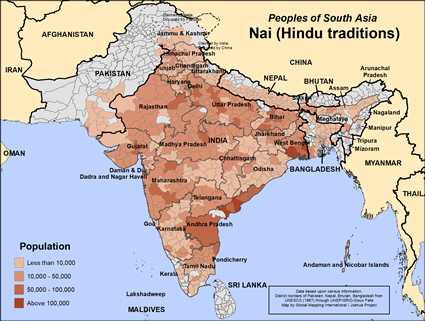Nai (Hindu traditions) in India

Photo Source:
Anonymous
|

Map Source:
People Group Location: Omid. Other geography / data: GMI. Map Design: Joshua Project
|
| People Name: | Nai (Hindu traditions) |
| Country: | India |
| 10/40 Window: | Yes |
| Population: | 12,208,000 |
| World Population: | 12,388,000 |
| Primary Language: | Hindi |
| Primary Religion: | Hinduism |
| Christian Adherents: | 0.00 % |
| Evangelicals: | 0.00 % |
| Scripture: | Complete Bible |
| Ministry Resources: | Yes |
| Jesus Film: | Yes |
| Audio Recordings: | Yes |
| People Cluster: | South Asia Hindu - Nai |
| Affinity Bloc: | South Asian Peoples |
| Progress Level: |
|
Introduction / History
The Hindu Nai people are located throughout the nation of India. Their traditional occupation is that of cutting hair and nails. The Nai are known by dozens of other names depending on what part of India they live in. The main language of the Nai is Hindi but they also speak the regional languages of where they reside. Unfortunately, many of the Hindu Nai are illiterate or functionally illiterate. The gospel will have to be shared with them in oral and visual forms. Many resources are available in Hindi including the complete Bible, radio programs and the JESUS Film.
What Are Their Lives Like?
The Nai are associated with the barber profession. The Nai groom their clients by as cutting hair and nails. They also provide minor medical services like extracting teeth and setting sprains right. The Nai often perform duties in connection with marriage, matchmaking and wedding celebrations. Nai women, called 'Naun ', are hairdressers, henna artists and midwives. The Nai tend to be quiet people, which is important to their trade. A large-scale occupational change is taking place with many Nai taking up other trades and professions in modern India. The literacy rate among the Nai is low. Many children leave school after a few years to help their parents earn a living. The traditional extended family is still common. Sons inherit equal shares in the family property and the eldest succeeds as head of the family. Nai women are secondary in status to males. A Nai caste council settle legal issues and promotes their interests with outsiders.
What Are Their Beliefs?
The Nai practice Hinduism, the ancient religion of India. They worship and serve the gods of the Hindu pantheon and their brand of Hinduism is influenced by folk religion. Hindus believe that by performing rituals and good works that they will attain moksha or freedom from the endless cycle of birth, death and rebirth. The Nai visit Hindu temples and offer prayers, food, flowers, and incense to their gods in hopes of gaining protection and benefits. They do not have a personal or familial relationship with their gods as Christians do. There are many forms of Hinduism, each with its own deities and beliefs. The main yearly holidays of the Nai people are Holi, the festival of colors and the start of spring, Diwali, the festival of lights, Navratri, the celebration of autumn and Rama Navami, Rama's birthday. The Nai give special prominence to their regional deities. The Nai believe in evil spirits who, along with local deities, are believed to cause trouble and diseases. The Nai frequently go to shamans for their spiritual and medical needs. The caste system divides Hindus into four main categories. The lowest communities are outside of the caste system. The Nai fit into the working caste.
What Are Their Needs?
The Nai need to learn new job skills and literacy. They need increased access to good schools, particularly for Nai women and girls. They also need access to modern medical facilities. The Nai need to know Jesus and His gospel. They need to be freed from being second-class citizens due to their caste ranking. They need to know that they can repent and become the children of God, members of His kingdom.
Prayer Points
Pray that Indian believers would build friendships with the Nai and tell them about the Savior. Pray for a disciple making movement that will bless the Nai people this decade. Ask the Lord to lead the Nai to listen to Christian radio programs in their languages.